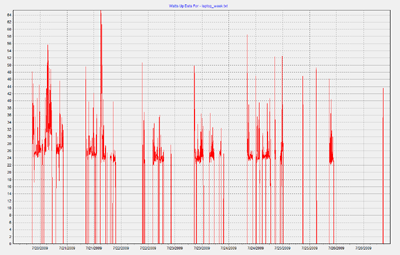If this article has helped you please take a moment to Contact us and share how. We hope you will invest in learning about energy by reviewing our Knowledge Directories - information on products that will help you save energy.
There are a number of articles to be found on the Internet that discuss ways to save energy when using a laptop computer. I thought it might be useful to publish the exact amounts of energy used over a 7 day period, 5 working days and 2 week-end days, showing the facts.
 The laptop used is a HP DV7 Pavilion, AMD Turion-X2 (35 Watts), 4 GB RAM, 320 GB Disk, 15.4" Display and Energy Star rated. The test was carried out by connecting a Watts up .NET meter to the laptop and storing the energy used every 1 second (this adjusted automatically over the week to optimize the meters storage capacity) This is the data for the week examined.
The laptop used is a HP DV7 Pavilion, AMD Turion-X2 (35 Watts), 4 GB RAM, 320 GB Disk, 15.4" Display and Energy Star rated. The test was carried out by connecting a Watts up .NET meter to the laptop and storing the energy used every 1 second (this adjusted automatically over the week to optimize the meters storage capacity) This is the data for the week examined.
My goal was to use the laptop in as typical a way as possible, while applying all the "human smart" energy savings techniques I knew. These include optimizing the power management settings, eliminating the screen saver, lowering the screen brightness, and putting the laptop to sleep whenever possible.
Note the vertical lines during each day going to zero power where I did this. I then calculated exactly how much additional energy would have been used; if I had been using the optimal power management settings without "human smarts"; if I had been using my original default settings including the 5 minute screen saver.
The results are quite something to digest. We are not going to save any planets, or retire early on this data. But, when described as a percentage, the picture takes on a whole new meaning. I would have been using 24.38% more energy if my laptop had been left using the default power settings it came with.
Laptop Power with display on 0% cpu: 24Watts
Laptop Power with display on 100% cpu: 64Watts (see graph peaks)
Laptop Average use Power: 29.55 Watts (lower than I expected)
Total use hours week days: 40.75 hours
Total use hours week-end days: 2.78 hours
Total energy consumed: 1.28 KWh
Total cost of energy @11.4cents/KWh: 14.72 cents
Annual cost assuming 48 weeks/year: $7.07
Energy saved by "putting" laptop to sleep: 0.15KWh - 11.72%
Energy Saved over default settings: 0.312KWh - 24.38%
The average energy consumption of 29.55 Watts seemed low compared to the 65Watt rating on the power supply. The AMD processor is rated at 35Watts so I did some additional tests at various processor loadings.
Laptop Power at 0% processor: 24.1 Watts
Laptop Power at 55% processor: 46.2 Watts
Laptop Power at 100% processor: 68.1 Watts
The increase of 44Watts is more than the 35Watts expected when considering the AMD processor rating? The additional consumption may have been used by by the system fans which increased speed significantly as the processor was stressed, and the increase in memory used by the stress utility, from 1.4GB to 4 GB.
We conclude that more than 50% of the laptop's rated power is used in proportion to the work being done by the processor.
I had been saving the results of this study, thinking it could be a center article around home office energy saving. I recently replaced the 100Watt light in my office, with a 25Watt halogen lamp. There are times I can use natural sunlight, but assuming that I have the lamp on for the full 43.53 hours I work at the computer each week, I save 3.265 KWh each week on light energy.
What can I say, this is 2.55 times what my computer uses. I do hope our readers will pay attention to this data, and realize that the issue is really one of attitude, being willing to "turn things off" and buying energy efficient products when the times comes.
Get Smart about Energy™

Testing
Your readers might find it interesting if you tested Microsoft's Joulemeter energy estimates against your actual measurements.
http://vertatique.com/?q=microsoft-release-free-software-estimating-virtual-machine-energy-use